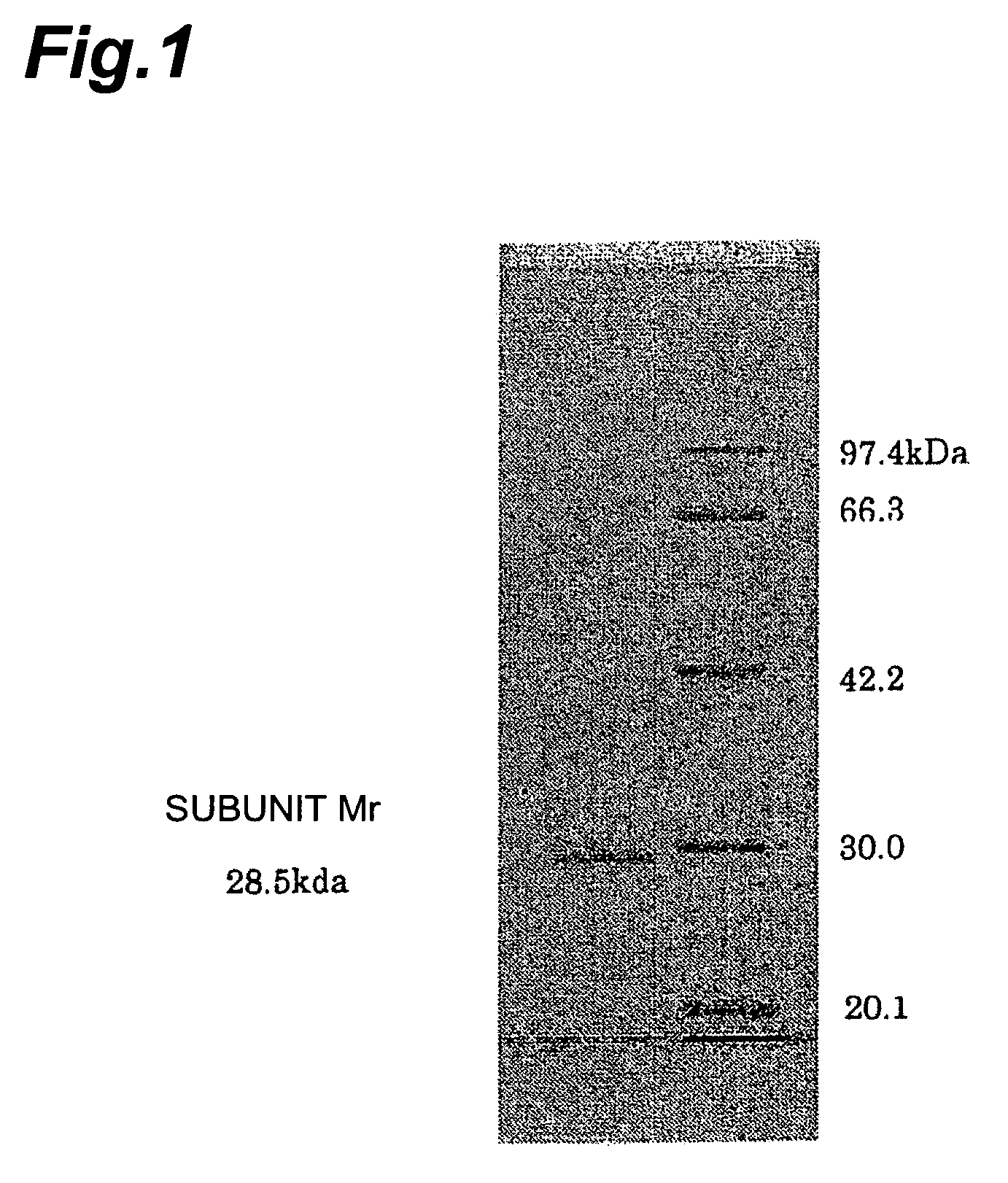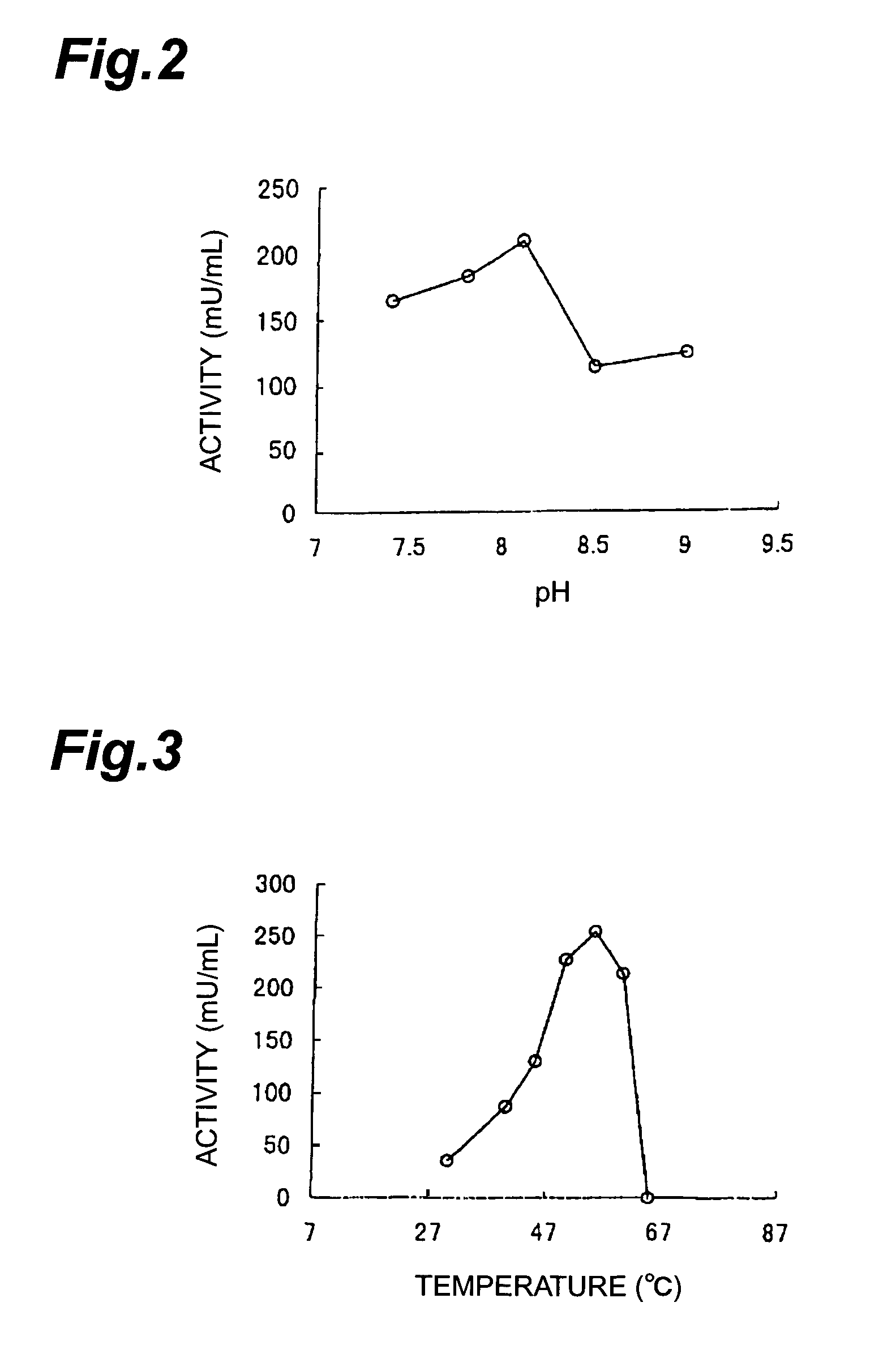Aminoketone asymmetric reductase and nucleic acid thereof
a technology of amino-asymetric reductase and nucleic acid, which is applied in the field of amino-asymetric reductase, can solve the problems of difficult recovery of diastereomers as materials and complicated steps, and achieves desirable optical activity, high selectivity, and high yield
- Summary
- Abstract
- Description
- Claims
- Application Information
AI Technical Summary
Benefits of technology
Problems solved by technology
Method used
Image
Examples
example 1
[0191](Purification of Aminoketone Asymmetric Reductase)
[0192]Rhodococcus erythropolis MAK-34 were planted in a test tube containing 5 ml of a medium having a composition (pH 7.0) comprising 1% of glucose, 0.3% of dipotassium hydrogenphosphate, 0.02% of magnesium sulfate heptahydrate, 1.5% of peptone, 0.2% of sodium chloride, and 0.1% of yeast extract, and were shaking-cultured at 28° C. for 3 days, and then were inoculated into 500 ml of a medium having the same composition, the shaking-culture was carried out at 28° C. for 3 days. Thus obtained preculture medium was inoculated into 50 l of a medium with addition of 0.1% of 1-amino-2-hydroxypropane to the above-mentioned composition, and the culture was carried out at 28° C. for 2 days.
[0193]Thus obtained culture medium was treated with a centrifuge, whereby 3785 g of wet cells were obtained. To 1 kg of the cells, 1000 ml of 10 mM Tris-hydrochloric acid buffer solution (pH 8.5) containing 10% of glycerol, 1 mM of nickel chloride, a...
example 2
[0206](Cloning of Aminoketone asymmetric Reductase Gene and Expression in Escherichia coli)
[0207](1) Determination of Amino Acid Partial Sequence of Purified Enzyme
[0208]One nmol of lyophilized aminoketone asymmetric reductase (as a subunit molecular weight of about 28,500) was dissolved into 50 μl of 50 mM Tris-hydrochloric acid buffer solution (pH 8.6) containing 8 M urea, and was denatured for 1 hour at 37° C. Added thereto were 50 μl of 50 mM Tris-hydrochloric acid buffer solution (pH 8.6), so as to yield a urea concentration of 4 M. With 0.5 μl (0.006 nmol, E / S=1 / 167) of 12 nmol / ml lysyl endopeptidase (Wako Pure Chemical) added thereto, digestion was performed for 6 hours at 30° C. The obtained digested peptides were collected through reversed-phase column (Amersham Pharmacia Biotech), and their amino acid sequences were analyzed by ABI 476A protein sequencer. The results were as follows:
[0209]1) MFNSIEGRSVVVTGGSK (N-terminal) (SEQ ID NO: 3)
[0210]2) RLGEMTSEDMDSVFGVNVK (SEQ ID ...
example 3
[0250](Production of d-(1S, 2S) Pseudoephedrine)
[0251]Each of the microorganisms listed in Table 1 was planted in 50 ml of a medium containing 1% of glucose, 0.5% of peptone, and 0.3% of yeast extract, and was shaking-cultured for 48 hours at 30° C. The culture medium was centrifuged to obtain the cells, which were then put into a test tube and suspended with 1 ml of 1 M sodium phosphate buffer solution (pH 7.0) added thereto. With 1 mg of dl-2-methylaminopropiophenone hydrochloride added thereto, the mixture was shaken for 24 hours at 30° C., so as to effect a reaction. After the reaction was completed, the reaction mixture was centrifuged, so as to remove the cells, and the supernatant was subjected to HPLC (μBondapakphenyl, manufactured by Waters Corporation, with a diameter of 4 mm, a length of 300 mm, an eluent of 0.05 M sodium phosphate buffer solution (containing 7% of acetonitrile), pH 5.0, a flow rate of 0.8 mL / min, and a detection wavelength of UV 220 nm), thereby yielding...
PUM
| Property | Measurement | Unit |
|---|---|---|
| temperature | aaaaa | aaaaa |
| temperature | aaaaa | aaaaa |
| pH | aaaaa | aaaaa |
Abstract
Description
Claims
Application Information
 Login to View More
Login to View More - R&D
- Intellectual Property
- Life Sciences
- Materials
- Tech Scout
- Unparalleled Data Quality
- Higher Quality Content
- 60% Fewer Hallucinations
Browse by: Latest US Patents, China's latest patents, Technical Efficacy Thesaurus, Application Domain, Technology Topic, Popular Technical Reports.
© 2025 PatSnap. All rights reserved.Legal|Privacy policy|Modern Slavery Act Transparency Statement|Sitemap|About US| Contact US: help@patsnap.com



